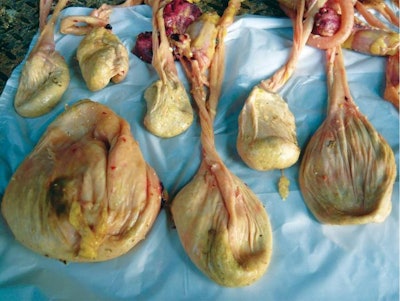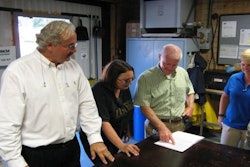Keeping a sharp focus on what’s happening in the poultry processing plant -- and in the wider market -- is essential if processing businesses are to make the most of opportunities and maximize profit.
There are general principles that need to be followed and key processing operations that must be closely monitored, but managers need to properly engage with what’s happening on the processing plant floor and not become over-reliant on technology. As importantly, they need to be able to respond quickly to market developments and opportunities.
For the broiler industry, the recent pronouncements by the World Health Organization (WHO) on processed and red meat offer enormous opportunities. Meat consumers will want alternatives, and the broiler industry needs to increase its efforts in the areas of marketing, production and processing.
Broiler farms more than ever will face the challenge of producing as much grade A chicken as possible to meet demand, while those in processing plants need to minimize processing waste to ensure that as much poultry meat as possible is produced as competitively as possible.

Broilers being transported to the processing plant must be handled with care to minimize the number of rejected final carcasses.
Vigilance from farm to plant
There are some basic rules that need to be followed to guarantee the smooth operation of the poultry processing plant.
To work as efficiently as possible, poultry processing plants need to ensure that poultry growers supply the correct type of bird in the best possible condition. Live producers must deliver birds that are the right size and weight, but they must also ensure that when broilers are caught they not harmed, as this could lead to rejections at the processing plant.
As far as the plant is concerned, it is essential to have the correct equipment, but also to have sufficient staff to ensure that chicken carcasses do not deteriorate due to delays in processing.
In poultry processing, paying close attention to the details in real time is what counts; simply measuring output volume is not enough, and it is this approach that will ensure a competitive market position.
Once these general, but important, principles have been addressed, there needs to be a particular focus on several key areas, starting back at the broiler farm.
Feed withdrawal period
If the feed withdrawal period is too long or too short, there will be an impact on evisceration.
Capture and caging
Capture and caging always needs to be performed with care and attention to minimize the stress experienced by the bird, but filled cages also need management to ensure that heat dissipates as efficiently as possible.
Heat stress
Heat stress can have an effect on the quality of finished product, and its impact can be seen in the wings and the thighs when birds are hung on the overhead conveyor.
Poor hanging on the shackles
If birds are hung onto the overhead conveyor carelessly, there will be a price to pay at stunning, bleeding, scalding and plucking operations.
Incorrect stunning
When birds are poorly stunned, plucking can be compromised. Many plants attempt to solve this by raising the scalding temperature and plucking more closely. The result, however, is more rejected birds and loss of yield.

Poor feed withdrawal with have implications for evisceration of the processed birds, as in this example of crops full of feed due to an overly-short withdrawal period.
Technology double-edged sword
Today’s technology can be a double-edged sword. Some employees increasingly operate virtually rather than actually participating, and the ease with which information can be accessed can result in staff knowing, or remembering less.
Operating virtually, without making engaged inspections, could result in problems in the processing plant being missed. This can be dangerous if failure to rectify immediately drags down the bottom line.
Similarly, if management goals are only stored on a device, and not kept, for example, in inspectors’ memories, there is the risk that goals will be not be checked.
Where there is an over-reliance on smartphones or other communication devices, this needs to be addressed sooner rather than later if productivity and profitability are not to decline. A failure to fully and properly engage with co-workers and colleagues, for example relying on apps, could result in missed opportunities to talk, and lost opportunities to improve the business.
There can be no doubt that today’s technology, despite the above-mentioned problems, brings advantages, and developments in the technology sector can act as an inspiration to poultry processing companies.
In the smartphone market in particular, there has been an emphasis on allowing the consumer to do more with apparently less, i.e. performing more tasks ever-more simply, regardless of age, education level, language, manual dexterity or geographic location.
This principle could as easily be applied to product innovation within the processing sector, where those tasked with improving the business or product range should always seek to achieve the “wow factor.”
Group focus for success
Bringing the focus of as many employees as possible onto the success of the business can help to maintain its competitiveness and ensure survival.
For example, the research and development department should not have sole responsibility for innovation in a company – an all-embracing approach needs to be adopted.
A company culture that places creativity and innovation at the heart of the business has a greater chance of survival. The entire workforce needs to be thinking each and every day of how daily operations and the individual processes of the plant can be improved. They also need to think about new ideas for products or segments that have yet to be explored.
Today’s world is highly competitive, ruthless and seldom sits still. Few companies can simply sit within their comfort zones and survive. There needs to be a constant focus on performance and reacting to change. Increasingly, poultry processing companies will be judged not on their performance per hour, but on their performance per second, and to survive every aspect of the business must run optimally.
To learn more, read
Good cold chain requires close monitoring during, post-processing

















